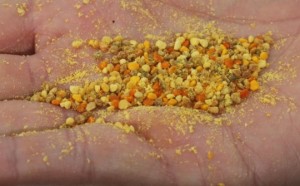Pesticides from Non-Crop Plants Affect Honeybees

Purdue researchers found that honeybees collect pollen from a wide range of plants, even in areas dominated by corn and soybeans. Credit: Purdue University/Tom Campbell
According to a recent study at Purdue University, honeybees are exposed to large quantities of pesticides from non-crop plants. The majority of plants pollinated by honeybees are uncultivated, largely in the clover and alfalfa family. In this study, the highest concentration of pesticides found in bee pollen came from the class of pyrethroids, which are toxic to bees and generally used as a household insecticides and mosquito repellent.
So what does this mean? Though conventional agriculture is to blame for causing stress to honeybees, it’s only part of the problem. Homeowners and landscapers treating their properties with herbicides, fungicides, and insecticides are also adding to the amount of chemicals to which honey bees are exposed.
The study sampled pollen from three different sites: “a nonagricultural meadow, the border of a cornfield planted with neonicotinoid-treated seeds and the border of a cornfield planted with non-treated seeds.” (Neonicotinoids, a class of chemicals commonly used to treat corn and soy crops, are also toxic to bees).
Researchers found about 30 different pesticides in each of the three sample locations, including neonicotinoids, pyrethroids, as well as DEET. The lead scientist stated that little is known about how different pesticides interact to affect bees.




Submit Comment